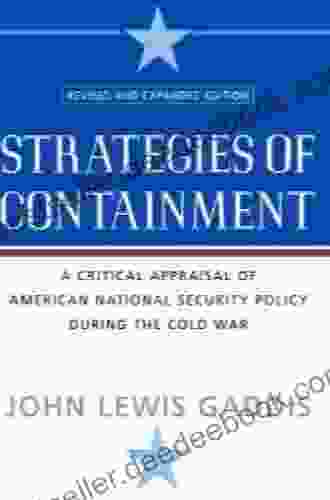A Critical Appraisal of American National Security Policy During the Cold War

The Cold War was a period of intense geopolitical tension between the United States and the Soviet Union and their respective allies. The conflict, which lasted from the late 1940s to the early 1990s, was largely characterized by mutual suspicion, arms build-ups, and proxy wars. American national security policy during the Cold War was guided by the overarching principles of containment, nuclear deterrence, and détente.
4.7 out of 5
| Language | : | English |
| File size | : | 1396 KB |
| Text-to-Speech | : | Enabled |
| Enhanced typesetting | : | Enabled |
| Word Wise | : | Enabled |
| Print length | : | 502 pages |
| Lending | : | Enabled |
| Screen Reader | : | Supported |
Containment
Containment was a key plank of American national security policy during the Cold War. The policy was predicated on the belief that the spread of communism could be prevented by encircling the Soviet Union and its satellite states with a ring of anti-communist alliances. The United States pursued a variety of strategies to achieve containment, including providing economic and military aid to friendly governments, supporting anti-communist insurgencies, and forming collective security arrangements such as NATO.
The policy of containment had a number of notable successes. It helped to prevent the Soviet Union from expanding its sphere of influence in Europe, and it contributed to the eventual collapse of the Soviet Union itself. However, containment also had its critics. Some argued that it was too confrontational and that it increased the risk of nuclear war. Others argued that it was too expensive and that it diverted resources away from other priorities such as economic development.
Nuclear Deterrence
Nuclear deterrence was another key element of American national security policy during the Cold War. The policy was based on the belief that the threat of nuclear retaliation would deter the Soviet Union from launching a nuclear attack. The United States maintained a large and sophisticated nuclear arsenal, and it developed a strategy of "massive retaliation" that threatened to unleash a devastating nuclear attack on the Soviet Union in the event of a nuclear attack on the United States or its allies.
The policy of nuclear deterrence was largely successful in preventing nuclear war. However, it also had its critics. Some argued that it was too risky and that it increased the likelihood of nuclear war by accident or miscalculation. Others argued that it was too expensive and that it diverted resources away from other priorities such as education and healthcare.
Détente
Détente was a period of reduced tensions between the United States and the Soviet Union that began in the late 1960s. The policy was based on the belief that both sides could benefit from a reduction in arms spending and a relaxation of tensions. The United States and the Soviet Union signed a number of arms control agreements during this period, and they also engaged in a number of cooperative initiatives such as the Apollo-Soyuz space mission.
The policy of détente had a number of notable successes. It helped to reduce tensions between the United States and the Soviet Union, and it contributed to the eventual end of the Cold War. However, détente also had its critics. Some argued that it was too conciliatory and that it gave the Soviet Union too much leeway. Others argued that it was too expensive and that it diverted resources away from other priorities such as defense.
American national security policy during the Cold War was a complex and multifaceted affair. The policy was guided by the overarching principles of containment, nuclear deterrence, and détente. Each of these principles had its own strengths and weaknesses, and each played a role in shaping the course of the Cold War.
The Cold War was a defining moment in American history. The policies that the United States adopted during this period had a profound impact on the course of the conflict and on the world as a whole. It is important to understand these policies in order to understand the Cold War and its legacy.
Back to Top
4.7 out of 5
| Language | : | English |
| File size | : | 1396 KB |
| Text-to-Speech | : | Enabled |
| Enhanced typesetting | : | Enabled |
| Word Wise | : | Enabled |
| Print length | : | 502 pages |
| Lending | : | Enabled |
| Screen Reader | : | Supported |
Do you want to contribute by writing guest posts on this blog?
Please contact us and send us a resume of previous articles that you have written.
 Book
Book Chapter
Chapter Text
Text Story
Story Genre
Genre Library
Library Paperback
Paperback Magazine
Magazine Paragraph
Paragraph Sentence
Sentence Bookmark
Bookmark Shelf
Shelf Foreword
Foreword Preface
Preface Synopsis
Synopsis Annotation
Annotation Scroll
Scroll Bestseller
Bestseller Library card
Library card Narrative
Narrative Biography
Biography Autobiography
Autobiography Memoir
Memoir Librarian
Librarian Card Catalog
Card Catalog Borrowing
Borrowing Stacks
Stacks Archives
Archives Periodicals
Periodicals Study
Study Reserve
Reserve Academic
Academic Journals
Journals Reading Room
Reading Room Rare Books
Rare Books Literacy
Literacy Study Group
Study Group Thesis
Thesis Reading List
Reading List Book Club
Book Club Anne Frasier
Anne Frasier Larry Atkins
Larry Atkins Gloria D Miklowitz
Gloria D Miklowitz Tracy Sugarman
Tracy Sugarman Donald E Westlake
Donald E Westlake Vb Coach In
Vb Coach In Padrika Gray
Padrika Gray Terese Cato
Terese Cato David Rosenmann Taub
David Rosenmann Taub Jennifer Jensen
Jennifer Jensen Elizabeth Buchanan
Elizabeth Buchanan Mervyn Cooke
Mervyn Cooke Alisha Sevigny
Alisha Sevigny Lee Giles
Lee Giles Louise Fein
Louise Fein Jennifer Adams
Jennifer Adams Amy W Knight
Amy W Knight George J Avlonitis
George J Avlonitis Richard F Welch
Richard F Welch Michael W Spicer
Michael W Spicer
Light bulbAdvertise smarter! Our strategic ad space ensures maximum exposure. Reserve your spot today!
 Ibrahim BlairFollow ·3.1k
Ibrahim BlairFollow ·3.1k Henry GreenFollow ·4.5k
Henry GreenFollow ·4.5k Willie BlairFollow ·17.1k
Willie BlairFollow ·17.1k Felipe BlairFollow ·18.9k
Felipe BlairFollow ·18.9k Juan RulfoFollow ·8.5k
Juan RulfoFollow ·8.5k Gary CoxFollow ·11.2k
Gary CoxFollow ·11.2k Cody RussellFollow ·5.2k
Cody RussellFollow ·5.2k Michael ChabonFollow ·8.2k
Michael ChabonFollow ·8.2k

 Brian Bell
Brian BellClassic Festival Solos Bassoon Volume Piano...
The Classic Festival Solos Bassoon Volume...

 Aubrey Blair
Aubrey BlairUnveiling the Courage: Insurgent Women Female Combatants...
In the face of armed...

 Jan Mitchell
Jan MitchellFor The Liberty Of Texas: The Lone Star State's Fight for...
The Republic of Texas was a sovereign state...

 Edgar Allan Poe
Edgar Allan PoeVisible, Explainable, Trustworthy, and Transparent...
What is VET2...
4.7 out of 5
| Language | : | English |
| File size | : | 1396 KB |
| Text-to-Speech | : | Enabled |
| Enhanced typesetting | : | Enabled |
| Word Wise | : | Enabled |
| Print length | : | 502 pages |
| Lending | : | Enabled |
| Screen Reader | : | Supported |















